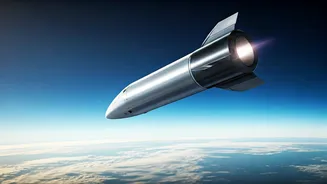Boosting Flight Endurance
SpaceX's initiative to upgrade its rockets directly addresses the need for extended flight durations in space. The objective goes beyond mere improvements
in propulsion; it encompasses a comprehensive overhaul of various critical systems within the rocket's structure. One primary focus is on enhancing the robustness of the rocket's components, allowing them to withstand the harsh conditions of space for longer periods. This involves selecting materials that are more durable and capable of withstanding extreme temperatures, radiation, and the vacuum of space, reducing the likelihood of mechanical failures. The engineers at SpaceX are also making improvements to the life-support systems, to keep astronauts safe and healthy on missions that extend beyond several weeks, months or even years. This necessitates incorporating more efficient recycling systems for air and water, as well as developing advanced technologies for waste management. Furthermore, the upgrades encompass enhancements to the rocket's power systems, ensuring that there is a dependable supply of energy to run all the necessary equipment on board.
Enhancing Reliability Features
Reliability is paramount for extended space missions, and SpaceX is concentrating considerable efforts on this aspect. The upgrades incorporate design modifications that provide backup systems for critical components, offering a redundancy that is intended to prevent total system failure. This includes employing multiple control systems to improve the likelihood of successful operation. Advanced diagnostic tools and real-time monitoring systems are also being implemented. These technologies will continuously assess the condition of the rocket's various systems, quickly identifying potential problems and allowing for prompt corrective actions. Moreover, the reliability enhancements extend to the rocket's software, which manages the systems in operation. Rigorous testing and validation protocols are being developed and implemented to ensure that the software is robust and free from vulnerabilities. All these measures aim to reduce the likelihood of in-flight failures and augment the overall reliability of the rockets, creating safer and more dependable space travel.
Advancements in Propulsion
The propulsion systems of SpaceX's rockets are also undergoing extensive improvements, forming a core part of the upgrade strategy. The focus is primarily on improving the efficiency of the engines, increasing their thrust, and reducing fuel consumption. SpaceX is exploring more sophisticated engine designs that can achieve improved performance through enhanced combustion and optimized nozzle configurations. These enhancements should lead to more effective use of propellants. Another key area of focus is the development of advanced fuel management systems. These systems are responsible for controlling the flow of propellants to the engines, and they need to be precise, especially during the various stages of the flight. By improving fuel management, SpaceX is striving to increase the range and payload capacity of their rockets, which is crucial for longer and more demanding space missions. The engineers are also examining the integration of innovative technologies, such as reusable rocket stages, which contribute to cost-effectiveness and reduce the environmental impact of space travel.
Crew Safety Measures
Crew safety is a top priority in SpaceX's upgrade projects. The improvements encompass a broad array of elements designed to protect astronauts during all phases of space travel. One key component involves strengthening the crew modules by reinforcing their structural integrity. These measures are intended to provide added protection against micrometeoroids and debris in space, as well as during launch and re-entry into Earth's atmosphere. Life support systems are being modernized to ensure a steady supply of oxygen, a comfortable environment, and proper waste management. The enhanced systems will be designed to handle the extended duration of longer missions. Emergency escape systems are also being improved, providing astronauts with a reliable means of escape during any unforeseen crisis. Furthermore, the rockets are being equipped with advanced communication systems to facilitate efficient communication with mission control. Regular medical monitoring and health protocols are also included to maintain the astronauts' well-being throughout the mission.
Boosting Payload Capacity
To support extended duration flights, SpaceX is increasing the rockets' payload capacity. This will enable them to carry more equipment, supplies, and scientific instruments into space. Structural improvements play a vital role in enhancing payload capability. By improving the design and materials of the rocket's core structure, SpaceX aims to carry larger and heavier payloads without compromising the rocket's performance or safety. Advanced engine technology is crucial, as more efficient engines can provide more thrust and greater lift capability. This leads to the ability to carry larger payloads to their destinations. SpaceX is also optimizing the rockets' aerodynamics to reduce drag and improve overall efficiency during flight. This enhances the rockets' ability to carry heavier loads. Improving the payload capacity is essential to the success of future long-duration missions, enabling the transport of more essential equipment and resources needed for space exploration.












